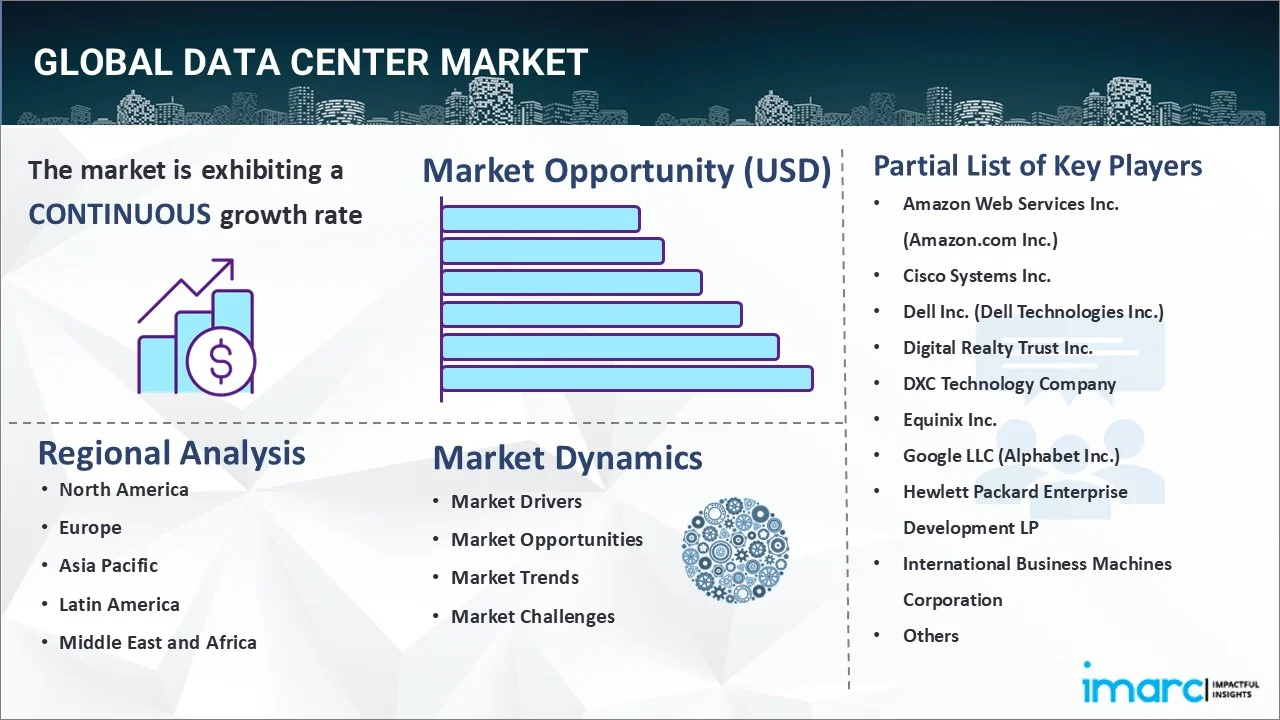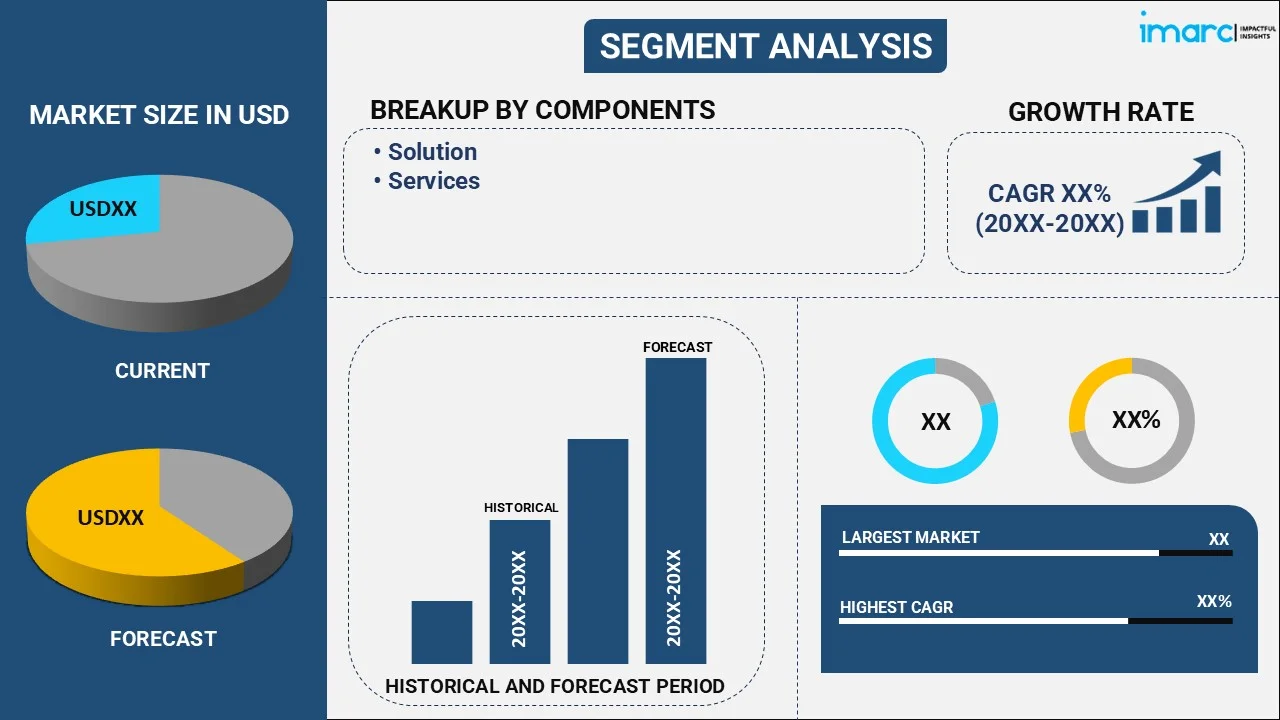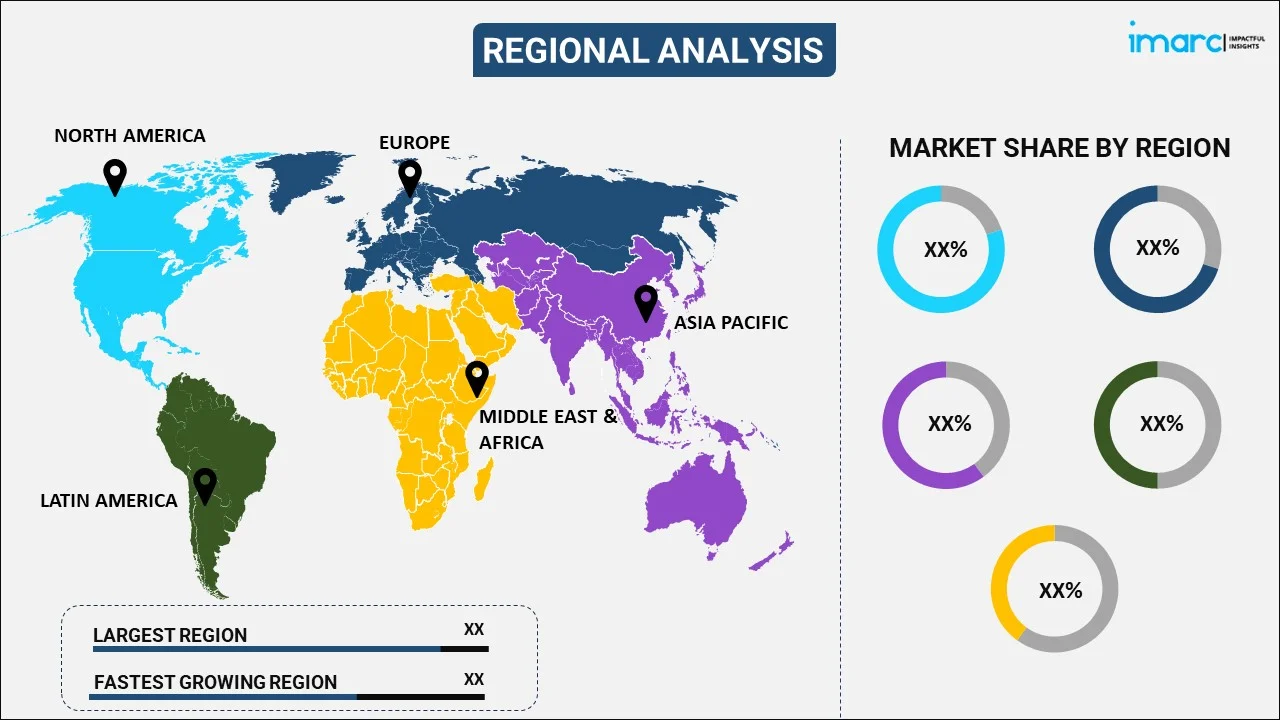
Data Center Market Report by Component (Solution, Services), Type (Colocation, Hyperscale, Edge, and Others), Enterprise Size (Large Enterprises, Small and Medium Enterprises), End User (BFSI, IT and Telecom, Government, Energy and Utilities, and Others), and Region 2025-2033
Data Center Market Size:
The global data center market size reached USD 213.6 Billion in 2024. Looking forward, IMARC Group expects the market to reach USD 494.5 Billion by 2033, exhibiting a growth rate (CAGR) of 9.29% during 2025-2033. The market demand for cloud services, data storage solutions, and edge computing is the primary driver of growth. Moreover, the market forecast indicates constant growth, supported by amplifying digital transformation, IoT adoption, and the expansion of energy-efficient and sustainable data center infrastructure globally.
|
Report Attribute
|
Key Statistics
|
|---|---|
|
Base Year
|
2024
|
|
Forecast Years
|
2025-2033
|
|
Historical Years
|
2019-2024
|
|
Market Size in 2024
|
USD 213.6 Billion |
|
Market Forecast in 2033
|
USD 494.5 Billion |
| Market Growth Rate (2025-2033) | 9.29% |
Data Center Market Analysis:
- Major Market Drivers: The increasing demand for cloud computing, big data analytics, and IoT applications is driving the growth of the data center market.
- Key Market Trends: The trend towards hyperscale data centers and edge computing is gaining momentum, as organizations seek to improve data processing speed and reduce latency.
- Geographical Trends: North America holds the largest market share, driven by early adoption, strong economy, established ecosystem, favorable regulations, and geographical advantages. In addition, the Asia Pacific region is experiencing rapid growth owing to the increasing digitalization and economic development.
- Competitive Landscape: The competitive landscape of the data center industry is highly dynamic, with a mix of established players and emerging startups. Major market players compete based on geographic footprint, data center capacity, network connectivity, and service offerings.
- Challenges and Opportunities: The industry faces challenges such as high energy costs, regulatory hurdles, and lack of skilled workforce. However, the growing demand for data center services also presents significant opportunities for expansion and innovation.

Data Center Market Trends:
Heightening Cloud Adoption and Hybrid Models
The global data center market growth is predominantly steered by the increasing cloud adoption and hybrid cloud models. As businesses are actively migrating their operations to the cloud, the requirement for cost-effective, flexible, and scalable data center solutions has propelled. Moreover, hybrid cloud models, which integrate on-premise data centers with both private and public cloud services, are rapidly being preferred for managing workloads, upgrading performance, and guaranteeing data security. In addition, this trend is driven by the demand for effective data management, improved flexibility, and minimized operational costs, especially as organizations deal with magnifying data volumes and sophisticated IT environments. As per industry reports, globally, 94% of companies utilize cloud computing services for their operations. Furthermore, 85% of organizations are anticipated to adopt a cloud-first principle by 2025.
Growing Shift Towards Sustainability and Green Data Centers
Sustainability has emerged as a key trend in the global data center market, with escalating emphasis on energy-saving and lowering environmental impact. Numerous companies are significantly investing in green data centers, leveraging renewable energy sources such as wind and solar power, and integrating energy-saving cooling systems. Furthermore, this shift is prompted by elevating energy costs, stricter regulatory policies, and corporate social responsibility programs As environmental concerns grow, data centers are increasingly adopting sustainable practices to reduce their carbon footprints while maintaining optimal performance. These efforts are driving advancements in energy management and eco-friendly infrastructure design, which in turn are contributing to the expansion of the data center market share. For instance, in October 2024, DSM Group unveiled its Eco Data Center in England, which is incorporated with leading-edge cooling technology and a 200kW of solar farm. This solar installation will provide renewable energy to execute operations within this green data center.
Increase in Edge Computing and Decentralization
The rising popularity of edge computing is revolutionizing the global data center market, with a notable inclination towards decentralization. Edge computing brings processing closer to data sources, significantly lowering latency and enhancing real-time decision-making. Moreover, this trend is majorly boosted by the accelerating adoption of Internet of Things (IoT) devices, 5G networks, and autonomous systems, which demand low latency and fast data processing. As per industry reports, globally, in 2023, 2.497 cities across 92 countries established operational commercial 5G networks. Furthermore, 23 countries are actively executing pre-commercial 5G trials, while 32 others announced plans to deploy 5G networks. In addition, by deploying smaller, localized data centers closer to devices as well as users, organizations can effectively upgrade performance, enhance customer experience, and minimize the load on conventional centralized data centers, improving overall network efficiency.
Data Center Market Segmentation:
IMARC Group provides an analysis of the key trends in each segment of the market, along with forecasts at the global, regional, and country levels for 2025-2033. Our report has categorized the market based on component, type, enterprise size, and end user.
Breakup by Component:

- Solution
- Services
Solution accounts for the majority of the market share
The report has provided a detailed breakup and analysis of the market based on the component. This includes solution and services. According to the report, solution represented the largest segment.
Breakup by Type:
- Colocation
- Hyperscale
- Edge
- Others
Hyperscale holds the largest share of the industry
A detailed breakup and analysis of the market based on the type have also been provided in the report. This includes colocation, hyperscale, edge, and others. According to the report, hyperscale accounted for the largest market share.
Breakup by Enterprise Size:
- Large Enterprises
- Small and Medium Enterprises
The report has provided a detailed breakup and analysis of the market based on the enterprise size. This includes large enterprises, and small and medium enterprises.
Breakup by End User:
- BFSI
- IT and Telecom
- Government
- Energy and Utilities
- Others
BFSI exhibits a clear dominance in the market
A detailed breakup and analysis of the market based on the end user have also been provided in the report. This includes BFSI, IT and telecom, government, energy and utilities, and others. According to the report, BFSI accounted for the largest market share.
Breakup by Region:

- North America
- United States
- Canada
- Asia Pacific
- China
- Japan
- India
- South Korea
- Australia
- Indonesia
- Others
- Europe
- Germany
- France
- United Kingdom
- Italy
- Spain
- Russia
- Others
- Latin America
- Brazil
- Mexico
- Others
- Middle East and Africa
North America leads the market, accounting for the largest data center market share
The report has also provided a comprehensive analysis of all the major regional markets, which include North America (the United States and Canada); Europe (Germany, France, the United Kingdom, Italy, Spain, Russia, and others); Asia Pacific (China, Japan, India, South Korea, Australia, Indonesia, and others); Latin America (Brazil, Mexico, and others); and the Middle East and Africa. According to the report, North America represents the largest regional market for data center. Some of the factors driving the North America data center market included the growing volume of digital data, the expanding adoption of cloud computing, artificial intelligence, machine learning, and the internet of things, and the surging demand for video streaming services.
Competitive Landscape:
The report has also provided a comprehensive analysis of the competitive landscape in the global data center market. Detailed profiles of all major companies have also been provided. Some of the companies covered include:
- Amazon Web Services Inc. (Amazon.com Inc.)
- Cisco Systems Inc.
- Dell Inc. (Dell Technologies Inc.)
- Digital Realty Trust Inc.
- DXC Technology Company
- Equinix Inc.
- Google LLC (Alphabet Inc.)
- Hewlett Packard Enterprise Development LP
- International Business Machines Corporation
- Microsoft Corporation
- NTT Communications Corporation (Nippon Telegraph and Telephone Corporation)
- Oracle Corporation
Kindly note that this only represents a partial list of companies and the complete list has been provided in the report.
Data Center Market News:
- In August 2024, Amazon Web Services announced the expansion of its data center operations in Telangana, India, as part of a strategy to augment cloud infrastructure and AI offerings in the country.
- In September 2024, Oracle announced plans to develop a gigawatt-scale data center, which will be powered by small modular nuclear reactors.
Data Center Market Report Scope:
| Report Features | Details |
|---|---|
| Base Year of the Analysis | 2024 |
| Historical Period | 2019-2024 |
| Forecast Period | 2025-2033 |
| Units | Billion USD |
| Scope of the Report | Exploration of Historical Trends and Market Outlook, Industry Catalysts and Challenges, Segment-Wise Historical and Future Market Assessment:
|
| Components Covered | Solution, Services |
| Types Covered | Colocation, Hyperscale, Edge, Others |
| Enterprise Sizes Covered | Large Enterprises, Small and Medium Enterprises |
| End Users Covered | BFSI, IT and Telecom, Government, Energy and Utilities, Others |
| Regions Covered | Asia Pacific, Europe, North America, Latin America, Middle East and Africa |
| Countries Covered | United States, Canada, Germany, France, United Kingdom, Italy, Spain, Russia, China, Japan, India, South Korea, Australia, Indonesia, Brazil, Mexico |
| Companies Covered | Amazon Web Services Inc. (Amazon.com Inc.), Cisco Systems Inc., Dell Inc. (Dell Technologies Inc.), Digital Realty Trust Inc., DXC Technology Company, Equinix Inc., Google LLC (Alphabet Inc.), Hewlett Packard Enterprise Development LP, International Business Machines Corporation, Microsoft Corporation, NTT Communications Corporation (Nippon Telegraph and Telephone Corporation), Oracle Corporation, etc. |
| Customization Scope | 10% Free Customization |
| Post-Sale Analyst Support | 10-12 Weeks |
| Delivery Format | PDF and Excel through Email (We can also provide the editable version of the report in PPT/Word format on special request) |
Key Questions Answered in This Report:
- How has the global data center market performed so far, and how will it perform in the coming years?
- What are the drivers, restraints, and opportunities in the global data center market?
- What is the impact of each driver, restraint, and opportunity on the global data center market?
- What are the key regional markets?
- Which countries represent the most attractive data center market?
- What is the breakup of the market based on the component?
- Which is the most attractive component in the data center market?
- What is the breakup of the market based on the type?
- Which is the most attractive type in the data center market?
- What is the breakup of the market based on the enterprise size?
- Which is the most attractive enterprise size in the data center market?
- What is the breakup of the market based on the end user?
- Which is the most attractive end user in the data center market?
- What is the competitive structure of the market?
- Who are the key players/companies in the global data center market?
Key Benefits for Stakeholders:
- IMARC’s industry report offers a comprehensive quantitative analysis of various market segments, historical and current market trends, market forecasts, and dynamics of the data center market from 2019-2033.
- The research report provides the latest information on the market drivers, challenges, and opportunities in the global data center market.
- The study maps the leading, as well as the fastest-growing, regional markets. It further enables stakeholders to identify the key country-level markets within each region.
- Porter's five forces analysis assists stakeholders in assessing the impact of new entrants, competitive rivalry, supplier power, buyer power, and the threat of substitution. It helps stakeholders to analyze the level of competition within the data center industry and its attractiveness.
- The competitive landscape allows stakeholders to understand their competitive environment and provides insight into the current positions of key players in the market.
Need more help?
- Speak to our experienced analysts for insights on the current market scenarios.
- Include additional segments and countries to customize the report as per your requirement.
- Gain an unparalleled competitive advantage in your domain by understanding how to utilize the report and positively impacting your operations and revenue.
- For further assistance, please connect with our analysts.
 Request Customization
Request Customization
 Speak to an Analyst
Speak to an Analyst
 Request Brochure
Request Brochure
 Inquire Before Buying
Inquire Before Buying




.webp)




.webp)












